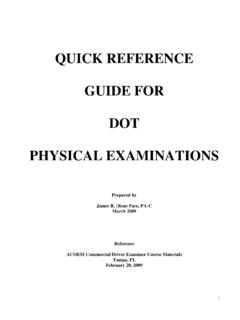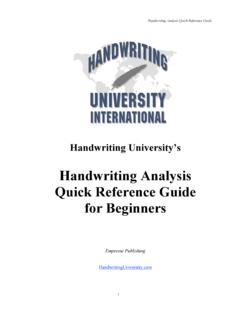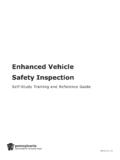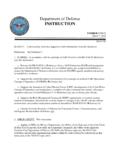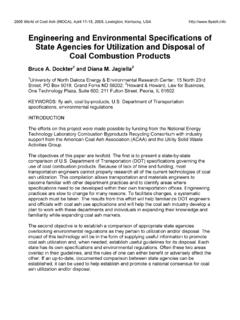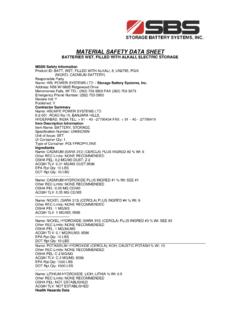Transcription of OHIO BASIC RIDER SKILLS CURRICULUM REVIEW MODEL …
1 MOP 0103 6/17 [760-1496] Page 1 of 11 OHIO DEPARTMENT OF PUBLIC SAFETY OHIO BASIC RIDER SKILLS CURRICULUM REVIEW MODEL national standards reference The information contained in this document compares and references the MODEL national standards for Entry-Level Motorcycle RIDER Training to the CURRICULUM . The first column in each table list the NHTSA MODEL national Standard for Entry-Level Motorcycle RIDER Training, DOT HS811 503 8/2011. The second column in each table, list the page (Pg.) number and the paragraph (p) number where the standard in the first column can be located in the RIDER guide. State volume number and printing year of RIDER guide.
2 Also submit an indexed to MODEL national Standard for. Entry-Level Motorcycle RIDER Training RIDER guide workbook. The third column in each table identifies by time index where on-line training, if used, meets the national standard. Provide an indexed copy of the on-line training modules. State version and date of digital materials . The fourth column identifies the range exercise where the standard in the first column is taught. Subsequent range exercises may offer additional practice in some SKILLS , Exercises are not referenced unless the primary exercise objective relates directly to the standard. Also submit an indexed to MODEL national Standard for Entry-Level Motorcycle RIDER Training, range cards.
3 State volume number and printing year of range cards . In addition to materials listed above, all instructor teaching materials and instructor training materials must be provided. 1. MOTORCYCLE PRE-RIDE TASKS The RIDER can identify and follows State laws, rules, and regulations pertaining to the operation of a motorcycle and equipment requirements. MODEL national Standard RIDER s Guide reference Page and Paragraph Digital Material Time Index reference Range Card reference Exercise Number(s) Identifies State laws, rules, and regulations for the operation of a motorcycle and equipment requirements. Demonstrates compliance with State laws, rules, regulations, and equipment requirements.
4 The RIDER can identify the mental and physical requirements for safe motorcycle operation and the procedures for getting ready to ride a motorcycle. MODEL national Standard RIDER s Guide reference Digital Material reference Range Card reference The mental and physical requirements of riding a motorcycle. Identifies the mental demands of riding a motorcycle as well as the increased crash risk when attention is not focused on the riding task. Identifies the physical demands of operating a motorcycle and whether or not they are physically capable of operating a motorcycle. Identifies the importance of riding free of all impairments and distractions, including alcohol and drugs.
5 Identifies the importance of choosing a motorcycle that fits their physical capabilities. MOP 0103 6/17 [760-1496] Page 2 of 11 Identifies special weather, roadway, and traffic conditions that may require additional mental or physical preparation. Demonstrates acceptance of and commitment to managing the risks associated with operating a motorcycle in a complex traffic and roadway environment. Performs a BASIC safety check that includes tires, chain, fluid levels, leaks, controls, horn, and lights. The RIDER can identify the characteristics of proper personal protective equipment and the importance of using it for protection, comfort, and conspicuity to manage the risks associated with riding a motorcycle.
6 MODEL national Standard RIDER s Guide reference Digital Material reference Range Card reference Uses a DOT compliant helmet and identifies helmet components and functions, proper fit and care, and potential defects. Uses eye and / or face protection and identifies available styles, function, and potential defects. Identifies the benefits of using hearing protection to minimize hearing loss. Uses over-the-ankle protective footwear and identifies the features that provide protection, support, and grip on footrests and road surfaces. Uses full-fingered gloves and identifies the features that provide proper fit, grip, and protection.
7 Uses long pants and identifies the features that provide protection and comfort. Uses long sleeves and identifies the features of a riding jacket that provides protection, comfort, and conspicuity. Identifies the features of rain and cold-weather gear that provides protection, comfort, and conspicuity in inclement weather. 2. VEHICLE CONTROL SKILLS The RIDER understands the primary controls and their proper use while maintaining functional control of the motorcycle. MODEL national Standard RIDER s Guide reference Digital Material reference Range Card reference Identifies the location and function of the primary motorcycle controls and information displays.
8 Demonstrates proper use of the primary motorcycle controls. The RIDER understands the proper techniques for mounting and starting a motorcycle. MODEL national Standard RIDER s Guide reference Digital Material reference Range Card reference Demonstrates proper technique for mounting the motorcycle. Demonstrates proper engine starting procedures. Demonstrates proper use of the side stand. MOP 0103 6/17 [760-1496] Page 3 of 11 The RIDER understands the proper techniques for stopping the engine, dismounting, and securing a motorcycle. MODEL national Standard RIDER s Guide reference Digital Material reference Range Card reference Demonstrates engine stopping procedures.
9 Demonstrates proper technique for dismounting a motorcycle. Identifies ways to properly secure a motorcycle. The RIDER understands the proper techniques for clutch and throttle control. MODEL national Standard RIDER s Guide reference Digital Material reference Range Card reference Keeps head and eyes up. Keeps four fingers on the clutch lever. Keeps right wrist flat or down and fingers on the throttle grip. Identifies the friction point of the clutch. Uses the friction point without fully releasing the clutch. Coordinates clutch and throttle to get smoothly underway.
10 The RIDER understands the proper techniques for riding in a straight line. MODEL national Standard RIDER s Guide reference Digital Material reference Range Card reference Demonstrates proper riding posture for head, eyes, back, knees, feet, elbows, hands, and arms. Balances the motorcycle. Keeps head and eyes up. Keeps fingers on the throttle grip. Demonstrates proper throttle control. The RIDER understands the proper techniques for slowing and stopping a motorcycle. MODEL national Standard RIDER s Guide reference Digital Material reference Range Card reference Keeps head and eyes up.
